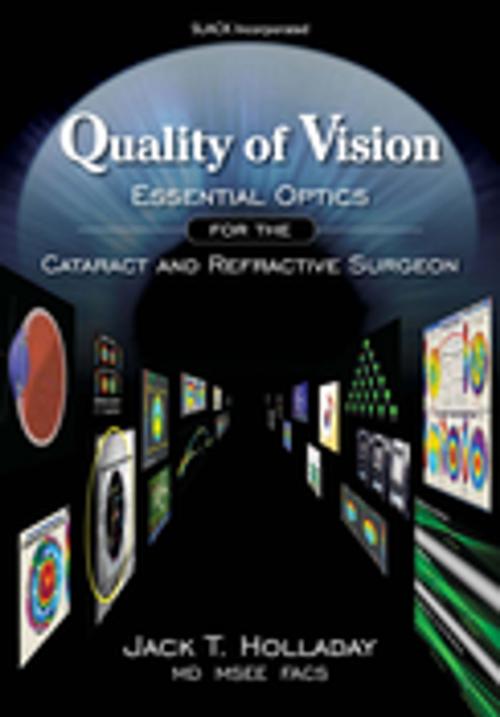Quality of Vision:
Essential Optics for the Cataract and Refractive Surgeon
Nonfiction, Health & Well Being, Medical, Specialties, Ophthalmology| Author: | ISBN: | 9781617112058 | |
| Publisher: | SLACK Incorporated | Publication: | November 15, 2006 |
| Imprint: | SLACK Incorporated | Language: | English |
| Author: | |
| ISBN: | 9781617112058 |
| Publisher: | SLACK Incorporated |
| Publication: | November 15, 2006 |
| Imprint: | SLACK Incorporated |
| Language: | English |
Good vision is more than 20/20 on a Snellen visual acuity chart. The modern ophthalmologist understands that contrast sensitivity, near and distance vision, performance under light and dark conditions, and the brain’s interpretation of input from the sensory apparatus, are all important elements in patients’ quality of vision. In Quality of Vision, ophthalmologist and optics expert Dr. Jack T. Holladay explores the elements of vision that lie beyond Snellen testing. He explains the “whys” behind the machinery, instruments, technology, and procedures commonly used to assess vision before and after cataract and refractive surgery. With a better understanding of these tools, ophthalmologists can deliver better vision for their cataract and refractive surgery patients. Quality of Vision addresses: Measuring and treating astigmatism in corneal and IOL surgery The importance of correcting spherical aberration in cataract and refractive surgery IOL calculations after refractive surgery Promising approaches to the correction of presbyopia Other practical topics the clinician can use every day Recognized as the leader in ophthalmic optics, Dr. Holladay incorporates practical aspects of daily practice into each chapter as he expertly explains the scientific principles, mathematical formulas, and theories behind these important issues. Additionally, Quality of Vision includes numerous color illustrations to provide visual representations of the text’s key points. Dr. Holladay discusses what’s on everyone’s mind: How to take the best measurements and perform the best calculations to ensure good outcomes in cataract and refractive surgery How neural adaptation can improve outcomes How today’s excimer laser systems deliver excellent optical correction, and why tomorrow’s systems will perform even better Quality of Vision is the most complete and practical reference for ophthalmologists looking to increase their understanding of optical physics and their ability to deliver good vision to their patients after cataract and refractive surgery. From the Foreword by Richard L. Lindstrom, MD: "In ten tightly written and well illustrated chapters Dr. Holladay brings the reader up-to-date on the core optics knowledge required to practice intelligently in today's environment. Clinically relevant optics that can be applied daily in the practice of ophthalmology is the purpose of this amazingly easy to read book. This book is extremely timely and its content is a must read for all ophthalmologists whose practice includes seeing patients who have or intend to undergo cataract or refractive surgery, which is nearly all of us. "
Good vision is more than 20/20 on a Snellen visual acuity chart. The modern ophthalmologist understands that contrast sensitivity, near and distance vision, performance under light and dark conditions, and the brain’s interpretation of input from the sensory apparatus, are all important elements in patients’ quality of vision. In Quality of Vision, ophthalmologist and optics expert Dr. Jack T. Holladay explores the elements of vision that lie beyond Snellen testing. He explains the “whys” behind the machinery, instruments, technology, and procedures commonly used to assess vision before and after cataract and refractive surgery. With a better understanding of these tools, ophthalmologists can deliver better vision for their cataract and refractive surgery patients. Quality of Vision addresses: Measuring and treating astigmatism in corneal and IOL surgery The importance of correcting spherical aberration in cataract and refractive surgery IOL calculations after refractive surgery Promising approaches to the correction of presbyopia Other practical topics the clinician can use every day Recognized as the leader in ophthalmic optics, Dr. Holladay incorporates practical aspects of daily practice into each chapter as he expertly explains the scientific principles, mathematical formulas, and theories behind these important issues. Additionally, Quality of Vision includes numerous color illustrations to provide visual representations of the text’s key points. Dr. Holladay discusses what’s on everyone’s mind: How to take the best measurements and perform the best calculations to ensure good outcomes in cataract and refractive surgery How neural adaptation can improve outcomes How today’s excimer laser systems deliver excellent optical correction, and why tomorrow’s systems will perform even better Quality of Vision is the most complete and practical reference for ophthalmologists looking to increase their understanding of optical physics and their ability to deliver good vision to their patients after cataract and refractive surgery. From the Foreword by Richard L. Lindstrom, MD: "In ten tightly written and well illustrated chapters Dr. Holladay brings the reader up-to-date on the core optics knowledge required to practice intelligently in today's environment. Clinically relevant optics that can be applied daily in the practice of ophthalmology is the purpose of this amazingly easy to read book. This book is extremely timely and its content is a must read for all ophthalmologists whose practice includes seeing patients who have or intend to undergo cataract or refractive surgery, which is nearly all of us. "















